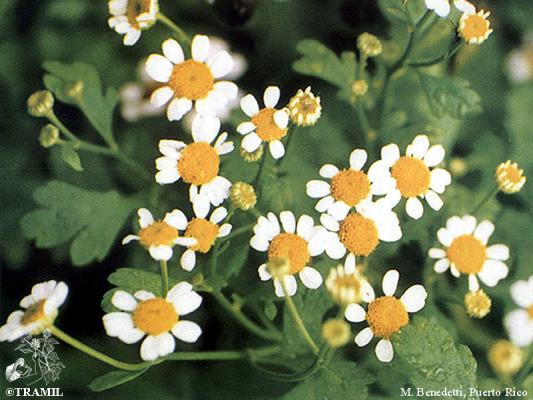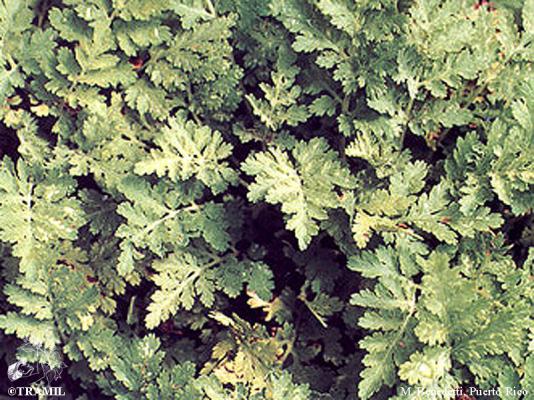Noms vernaculaires
(dans les territoires avec usage significatif TRAMIL)
Guatemala:
- altamiza
Distribution géographique
Originaire de l’est de l’Europe, largement répartie sous forme spontanée.
Description botanique
Herbacée pérenne, suffrustescente, aromatique, pouvant atteindre 1 m. Feuilles ovées à oblongues-ovées d’environ 12 cm, les inférieures étant pennées et pennatiséquées, les supérieures très pennatipartites; 2 ou 3 paires de segments, dentés, obtus. Capitules atteignant souvent 2 cm de diamètre; disque jaune; fleurs radiées blanches.
Voucher(s)
Girón,165,CFEH
Pharmacopée
Ed.3References
1 GIRON L, 1988
Encuesta TRAMIL (Costa atlántica). Centro Mesoamericano de Tecnología CEMAT, Guatemala, Guatemala.
2 ALONSO JR, 1998
Tratado de fitomedicina. Bases clínicas y farmacológicas. Buenos Aires, Argentina: Ed. ISIS S.R.L. p910.
3-19 AWANG DV, 1998 Prescribing therapeutic feverfew (Tanacetum parthenium (L.) Schultz Bip., syn. Chrysanthemum parthenium (L.) Bernh.). Integrative Med 1(1):11-13.
4 WILLIAMS CA, HOULT JR, HARBORNE JB, GREENHAM J, EAGLES J, 1995
A biologically active lipophilic flavonol from Tanacetum parthenium. Phytochemistry 38(1):267-270.
5 DOLMAN DM, KNIGHT DW, SALAN U, TOPLIS D, 1992
A quantitative method for the estimation of parthenolide and other sesquiterpene lactones containing alpha-methylene-butyrolactone functions present in feverfew, Tanacetum parthenium. Phytochem Anal 3(1):26-31.
6 BARSBY RW, SALAN U, KNIGHT DW, HOULT JR, 1993
Feverfew and vascular smooth muscle: extracts from fresh and dried plants show opposing pharmacological profiles, dependent upon sesquiterpene lactone content. Planta Med 59(1):20-25.
7 WAGNER H, FESSLER B, LOTTER H, WRAY V, 1988
New chlorine-containing sesquiterpene lactones from Chrysanthemum parthenium. Planta Med 54(2):171-172.
8 BEGLEY MJ, HEWLETT MJ, KNIGHT D, 1989
Revised structures for guaianolide alpha-methylenebutyrolactones from feverfew. Phytochemistry 28(3):940-943.
9 SCHULTZ BI, BANTHORPE DV, BROWN GD, JANES JF, MARR IM, 1990
Parthenolide and other volatiles in the flowerheads of Tanacetum parthenium (L.). Flavour Fragrance J 5:183-186.
10 PLOUVIER V, 1985
Occurrence and distribution of syringoside, calycanthoside and similar coumarinic glycosides in several botanical groups. CR Acad Sci Ser III 301(4):117-120.
11 JAIN NK, KULKARNI SK, 1999
Antinociceptive and anti-inflammatory effects of Tanacetum parthenium L. extract in mice and rats. J of Ethnopharmacol 68(1-3):251–259.
12 BHAKUNI DS, BITTNER M, MARTICORENA C, SILVA M, WELDT E, MELO ME, ZEMELMAN R, 1974
Screening of Chilean plants for antimicrobial activity. Llyodia 37(4):621-632.
13 CACERES A, SAMAYOA B, 1989
Tamizaje de la actividad antibacteriana de plantas usadas en Guatemala para el tratamiento de afecciones gastrointestinales. Guatemala: Dirección General de Investigaciones, Univers. San Carlos (DIGI-USAC).
14 BALDWIN CA, ANDERSON LA, PHILLIPSON JD, 1987
What pharmacists should know about feverfew. Pharm J 239:237-238.
15 JOHNSON ES, KADAM NP, HYLANDS DM, HYLANDS PJ, 1985
Efficacy of feverfew as prophylactic treatment of migraine. Br Med J 291:569-573.
16 ANON, 1994
Fitoterapia. Vademecum de prescripción de plantas medicinales. Asociación Española de Médicos Naturistas y Colegio Oficial de farmacéuticos de Vizcaya. Tanacetum parthenium 2da. Ed. España: CITA Publicaciones y Documentaciones. pp231-232.
17 ANON, 1996
British Herbal Pharmacopoeia, Tanacetum parthenium.4th ed. Bournemouth, Great Britain: British Herbal Medicine Association. pp81-82.
18 Newall C, Anderson L, PhillIpson D, 1996
Herbal medicines: A guide for health care professionals. The Pharmaceutical Press, London, England. p121.
19 GIRON L, CACERES A, FREIRE V, ALONZO A, SALVADOR L, 1995
Folleto informativo sobre algunas plantas comúnmente utilizadas por la población Garífuna de Livingston, Guatemala, Guatemala, p13.








